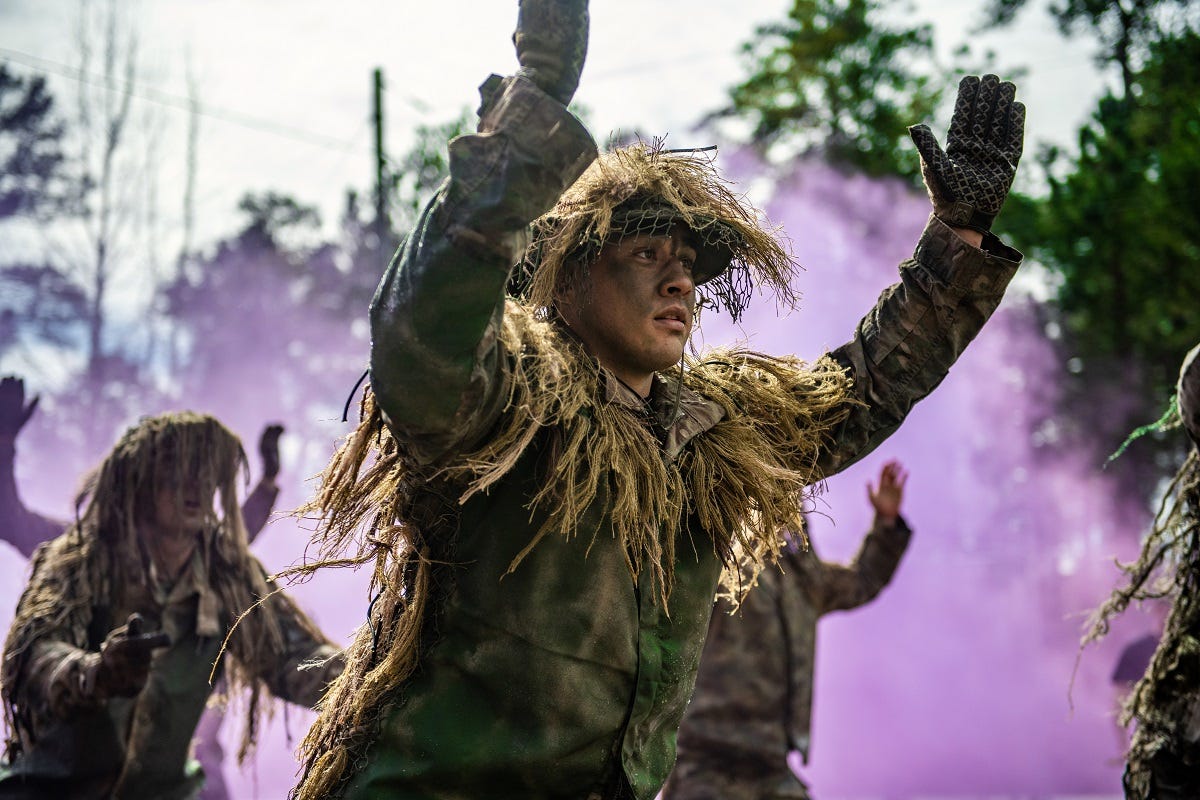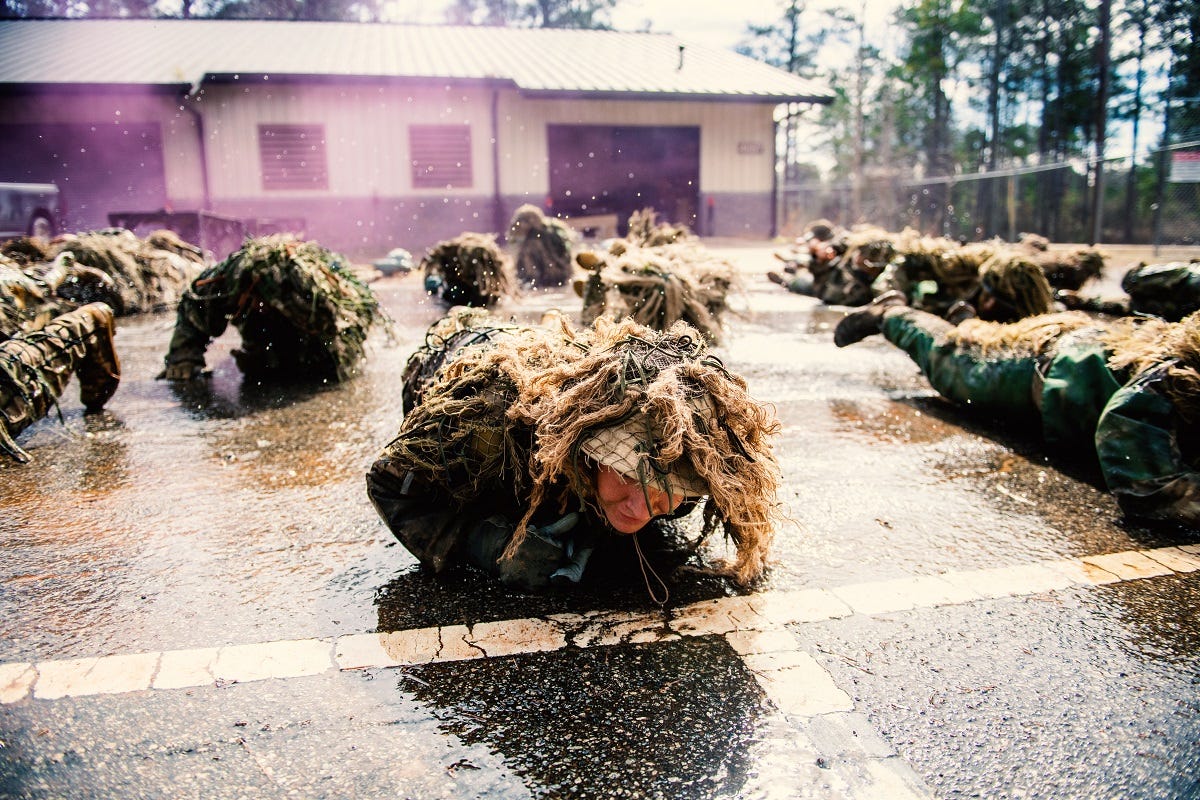
U.S. Army photo by Patrick A. Albright, Maneuver Center of Excellence and Fort Benning Public Affairs
- US Army sniper school students recently went through the “ghillie wash” and the photos are wild.
- The event puts sniper students through their paces and their ghillie suits to the test.
- A clean, fresh-looking ghillie suit could get the sniper killed in combat.
- Visit the Business section of Insider for more stories.
Aside from the rifle, a sniper’s ghillie suit is probably the most important piece of equipment he carries and is considered essential for camouflage, concealment, and stealth.
Ghillie suits are a kind of artificial camouflage that snipers create by affixing jute, twine and strips of other materials to a canvas uniform. In the field, vegetation is added to further break up the sniper’s outline, making them tougher to spot.
At US military sniper schools, students spend several weeks crafting their ghillie suits before putting them to the test in a ritual known as the ghillie wash, which is about as far from a “wash” as possible.
Recently, 35 students at the US Army’s sniper school at Fort Benning in Georgia went through the wash, using mud, water, and sand to perfect their ghillie suits for future combat.
Photos from the latest ghillie wash taken by Army photographer Patrick Albright are pretty wild.

U.S. Army photo by Patrick A. Albright, Maneuver Center of Excellence and Fort Benning Public Affairs
During the ghillie wash, students are put through their paces, as the wash is intended to mentally and physically challenge students to prepare them for the intense hardships they will face as snipers, considered to be one of the toughest and most dangerous jobs in the military.
The event also tests the strength and durability of a sniper's ghillie suit and weathers it to ensure that the wearer can effectively blend in with his surroundings, which is not only critical for mission success but also a sniper's survival.

U.S. Army photo by Patrick A. Albright, Maneuver Center of Excellence and Fort Benning Public Affairs
As Insider previously reported in a post on Marine Corps Scout Snipers, a clean, fresh-looking ghillie suit could get the sniper killed in combat.

U.S. Army photo by Patrick A. Albright, Maneuver Center of Excellence and Fort Benning Public Affairs
The ghillie suit as a tool for military snipers has been around for more than a century.
The suits originated in Scotland as a form of camouflage worn by hunters and gamekeepers known as gilles, a word for outdoor servants. The Scottish Gaelic word is said to be linked to a mythical creature known as the Gille Dubh (also known as the Ghillie Dhu) who dressed in leaves and other foliage.
The unusual garb was first used on the battlefield by Scottish marksman during the Second Boer War around the turn of the 20th century. That same Scottish unit formed the British Army's first sniper unit during World War I. The suit would later be adapted by other militaries, including the US armed forces.
Although there have been upgrades, the basic ghillie suit concept remains largely unchanged.

U.S. Army photo by Patrick A. Albright, Maneuver Center of Excellence and Fort Benning Public Affairs
In a well-made ghillie suit properly decked out with foliage, a sniper can lie only a few feet from an enemy undetected, as a Marine Corps Scout Sniper instructor previously demonstrated in a training event attended by Insider.

U.S. Army photo by Patrick A. Albright, Maneuver Center of Excellence and Fort Benning Public Affairs
But it is not the ghillie suit alone that makes a sniper a master of camouflage and concealment, snipers have told Insider.

U.S. Army photo by Patrick A. Albright, Maneuver Center of Excellence and Fort Benning Public Affairs
"Ghillie suits make people feel like they are invisible," a sniper instructor said. "The vegetation and the camouflage, that's only one part of it. It's more route selection and movement. It's about what you are putting between you and the target."

U.S. Army photo by Patrick A. Albright, Maneuver Center of Excellence and Fort Benning Public Affairs
A Marine Corps Scout Sniper is actually credited with successfully sneaking up on a target and getting two shots off in a training exercise wearing nothing but a brightly-colored safety vest.

U.S. Army photo by Patrick A. Albright, Maneuver Center of Excellence and Fort Benning Public Affairs
Ghillie suits, like face paint, false screens, constructed sniper hides, are just tools. It's a sniper's knowledge of his environment and surroundings, his understanding of how to employ the tools at his disposal, and his unparalleled marksmanship that make him a deadly and unstoppable force.

U.S. Army photo by Patrick A. Albright, Maneuver Center of Excellence and Fort Benning Public Affairs
